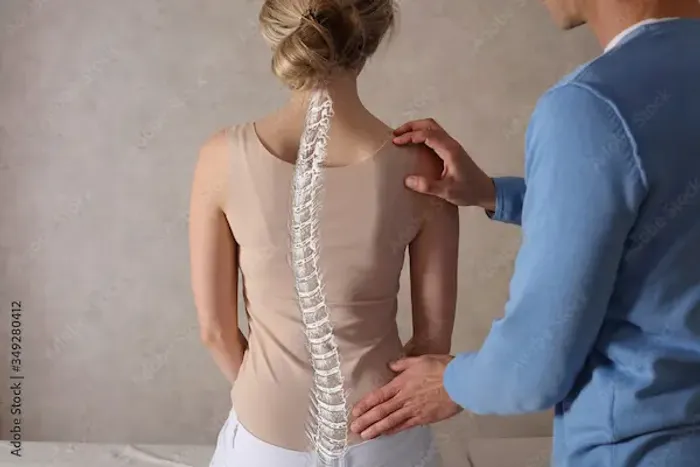All About Scoliosis: Understanding, Managing, and Living with Curved Spines
Learn everything about scoliosis, including its causes, symptoms, treatment options, and tips for managing and living with a curved spine. Discover effective strategies for scoliosis care and support.

Written by Dr. Sonia Bhatt
Last updated on 3rd Jul, 2025

Introduction
Scoliosis is a medical condition characterised by an abnormal sideways curvature of the spine, forming an "S" or "C" shape rather than the normal front-to-back curve. Though often detected during childhood or adolescence, scoliosis can affect people of all ages. In this article, we’ll explore what scoliosis is, the different types of scoliosis, how it develops, treatment options, and how to live well with the condition.
What is Scoliosis?
Scoliosis is a medical condition characterised by an abnormal lateral (sideways) curvature of the spine. Instead of a straight line when viewed from the back, the spine of someone with scoliosis curves in an "S" or "C" shape. This curvature can occur in different parts of the spine, including the cervical (neck), thoracic (mid-back), or lumbar (lower back) regions.
Types of Scoliosis
Scoliosis can be classified into several types based on the underlying cause and the age at which it develops, such as:
1. Idiopathic Scoliosis
Idiopathic Scoliosis is the most common type, accounting for about 80-85% of cases. The term "idiopathic" means that the cause of the condition is unknown. It is usually diagnosed in children and adolescents between the ages of 10 and 18 years old. This type of scoliosis is further classified based on the age of onset:
Infantile Idiopathic Scoliosis: Occurs in children from birth to 3 years old.
Juvenile Idiopathic Scoliosis: Occurs in children aged 4 to 10 years.
Adolescent Idiopathic Scoliosis: Occurs in adolescents aged 10 to 18 years and is the most common form of idiopathic scoliosis.
2. Congenital Scoliosis
Congenital Scoliosis results from a malformation of the spine present at birth. This type is relatively rare, occurring due to a failure of the vertebrae to form properly during embryonic development. Children with congenital scoliosis often have other health issues related to the heart, kidneys, and other parts of the body.
3. Neuromuscular Scoliosis
Neuromuscular Scoliosis is associated with neuromuscular diseases, which affect the nerves and muscles. Conditions like cerebral palsy, muscular dystrophy, spinal muscular atrophy, and spina bifida can lead to this type of scoliosis. The curvature in neuromuscular scoliosis tends to be more severe and progresses more rapidly compared to other types.
4. Degenerative Scoliosis
Degenerative Scoliosis, also known as adult scoliosis, occurs due to the degeneration of the spinal discs and joints that accompany ageing. This type typically affects individuals over the age of 50 and can be associated with osteoporosis, disc degeneration, and arthritis. The curvature in degenerative scoliosis is often accompanied by back pain and symptoms related to spinal stenosis.
5. Syndromic Scoliosis
Syndromic Scoliosis occurs in individuals who have a syndrome that affects various systems in the body. Conditions such as Marfan syndrome, Ehlers-Danlos syndrome, Rett syndrome, and neurofibromatosis are examples of syndromes that can be associated with scoliosis. The characteristics and progression of scoliosis depend on the underlying syndrome.
Symptoms of Scoliosis
The symptoms of scoliosis can vary depending on the severity and location of the curve. Common symptoms include:
Uneven shoulders or waist
One shoulder blade is more prominent than the other
Back pain
Difficulty standing upright
One hip higher than the other
A rotating spine causes one side of the rib cage to jut out
Diagnosing Scoliosis
Diagnosis of scoliosis typically involves a physical examination and imaging tests:
Physical Examination: The doctor will assess the alignment of the spine and check for any visible asymmetry, such as uneven shoulders, waist or hips.
X-rays: These imaging tests are the most accurate way to determine the degree of curvature and monitor progression over time.
MRI or CT scans: These may be used in cases where there is concern about underlying conditions that could be contributing to the scoliosis, such as a spinal tumour or nerve issues.
How Scoliosis Affects Daily Life?
The impact of scoliosis on a person’s daily life varies based on the severity and type of curvature. In many cases, individuals with mild scoliosis can lead normal, active lives without any major limitations. However, as the condition progresses, it can cause discomfort, pain, and complications that affect mobility and quality of life.
In severe cases, scoliosis can lead to breathing complications due to the compression of the lungs. The abnormal curve can also place additional stress on the back and neck muscles, leading to chronic pain or stiffness.
Treatment Options for Scoliosis
While there is no one-size-fits-all approach to treating scoliois, several options are available depending on the curve's severity, the patient's age, and the underlying cause of the condition.
1. Observation
In mild cases of scoliosis, especially in children and adolescents, doctors may recommend regular monitoring to ensure that the curve does not worsen. X-rays are often taken periodically to assess the progression of the curve. If the curvature is less than 20 degrees, treatment may not be necessary, and only observation is required.
2. Bracing
For moderate scoliosis (curves between 25 and 40 degrees), wearing a back brace can help prevent the curve from worsening, especially in growing children. The brace does not straighten the spine but helps prevent further progression during the growth years. Bracing is most effective when worn consistently as prescribed by the doctor.
3. Physical Therapy
Physical therapy is another non-surgical treatment that can help individuals with scoliosis manage pain, improve posture, and strengthen the muscles supporting the spine. Specific exercises may be recommended to improve flexibility and strength in the back and core, which can help alleviate discomfort and improve overall spinal health.
4. Surgical Intervention
Surgery may be recommended for individuals with severe scoliosis (curves greater than 45 to 50 degrees) or if the curve is causing significant pain, respiratory problems, or other complications. The most common surgical procedure for scoliosis is spinal fusion, which involves joining two or more vertebrae together using metal rods, screws, and bone grafts. This procedure helps to stabilise the spine and prevent further curvature.
While surgery can significantly improve spinal alignment and prevent further progression, it is generally considered a last resort after other treatments have been explored.
Managing Scoliosis: Tips for Daily Living
For many people with scoliosis, managing the condition effectively involves a combination of lifestyle adjustments, exercise, and regular medical check-ups. Here are some tips to help manage scoliosis and improve your quality of life:
Maintain a Healthy Weight: Excess weight can put additional strain on the spine, worsening scoliosis symptoms. Eating a balanced diet and staying active can help maintain a healthy weight and reduce stress on your back.
Practice Good Posture: Sitting and standing with proper posture can help alleviate some of the discomfort associated with scoliosis. Make sure your shoulders are aligned with your hips, and avoid slouching.
Stay Active: Engaging in regular physical activity can help strengthen the muscles around the spine, improve flexibility, and reduce pain. Low-impact exercises such as swimming, yoga, and walking are great options.
Avoid Heavy Lifting: Lifting heavy objects can strain the back and potentially worsen scoliosis. If you need to lift something, use proper lifting techniques, and avoid lifting objects that are too heavy for you.
Wear Comfortable Shoes: Footwear can affect the alignment of your spine. Choose shoes with good arch support and cushioning to help maintain proper posture.
See Your Doctor Regularly: Regular check-ups with your healthcare provider are essential to monitor the progression of scoliosis and ensure that any necessary treatments are implemented.
Living with Scoliosis
While scoliosis can present challenges, it’s important to remember that many people with the condition lead fulfilling, active lives. Whether you have mild or severe scoliosis, working closely with your healthcare team for personalised guidance and adopting a proactive approach to managing your condition can help you maintain mobility, reduce pain, and improve your overall well-being.
Conclusion
Scoliosis is a complex condition that requires careful monitoring and management. Understanding its causes, symptoms, diagnosis, and treatment options is essential for effective management and maintaining a good quality of life. Early detection and intervention can significantly improve outcomes and help individuals lead healthier lives.
Consult Top Orthopaedician
Consult Top Orthopaedician
Dr. Anil Sharma
Orthopaedician
42 Years • MBBS, MS Orthopedics
New Delhi
AAKASH MEDSQUARE, New Delhi

Dr. Manoj Dinkar
Orthopaedician
15 Years • MBBS, Dip (Orthopaedics)
New Delhi
THE DOCTORS NESST, New Delhi

Dr. Sushruth J
Orthopaedician
5 Years • MBBS, MS (ORTHOPEDICS),Fellowship in Arthroplasty,FRGUHS – Spine surgery,FIFA Diploma in Football Medicine
Bengaluru
Apollo Clinic, JP nagar, Bengaluru

Dr. Vishruta A V
Orthopaedician
5 Years • MBBS MS Orthopaedics
Bengaluru
Apollo Clinic, JP nagar, Bengaluru

Dr. Susheel B
Orthopaedician
13 Years • MBBS, MS, Ortho Fellowship in Trauma ( Germany) Fellowship in Arthroscopy and Arthroplasty ( Switzerland)
Bengaluru
Apollo Medical Center, Marathahalli, Bengaluru
